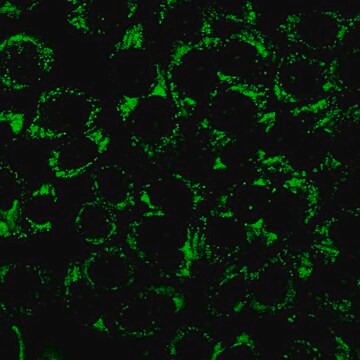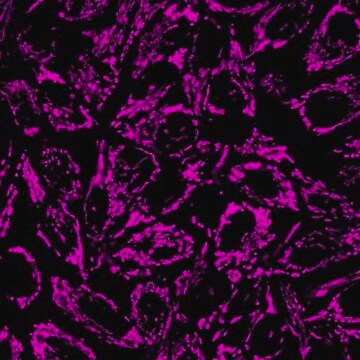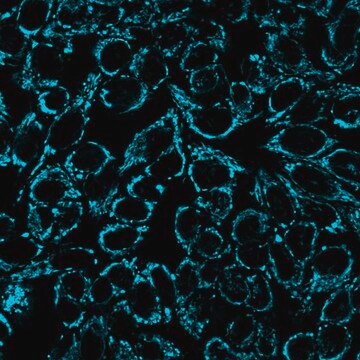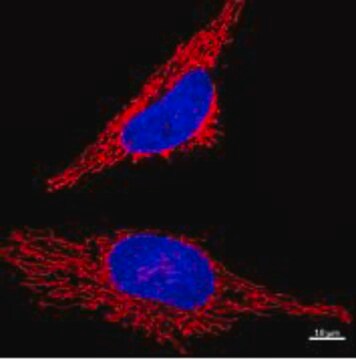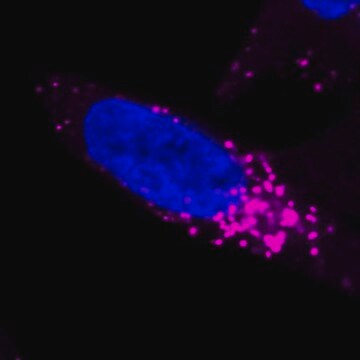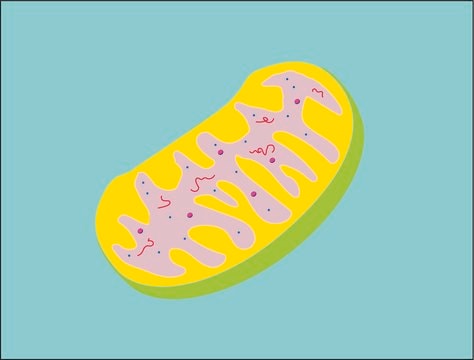CS0390
Mitochondria Staining Kit
1 kit sufficient for 40 tests (of 5 mL cell suspensions), 1 kit sufficient for 200 tests (of 1 mL cell suspensions)
Sinonimo/i:
JC-1 dye
About This Item
Prodotti consigliati
Livello qualitativo
impiego
kit sufficient for 200 tests (of 1 mL cell suspensions)
kit sufficient for 40 tests (of 5 mL cell suspensions)
Confezionamento
pkg of 1 kit
Condizioni di stoccaggio
dry at room temperature
tecniche
flow cytometry: suitable
protein staining: suitable
Fluorescenza
λex 490 nm; λem 530 nm (green) (JC-1 monomers)
λex 525 nm; λem 590 nm (red) (JC-1 aggregates)
applicazioni
cell analysis
detection
Metodo di rivelazione
fluorometric
Condizioni di spedizione
wet ice
Temperatura di conservazione
2-8°C
Descrizione generale
Applicazioni
Caratteristiche e vantaggi
- A fast, simple, and convenient method for staining and assaying mitochondria intactness
- Contains all the reagents required for the detection of changes mitochondrial inner-membrane electrochemical potential
- Contains the antibiotic valinomycin, which can be used as a control agent that prevents JC-1 aggregation
- The shift in fluorescence is clearly detectable in both green and red channels
- Suitable for adherent cells as well as cells in suspension
- Has been tested with Jurkat, U-937, HeLa, NIH3T3 cells
- The fluorescence signal can be observed by fluorescence microscopy or measured by flow cytometry
Solo come componenti del kit
- DMSO 1 mL
- JC Staining Buffer 5X 120 mL
- JC-1 1 mg
- Valinomycin Ready Made .1 mL
Codice della classe di stoccaggio
10 - Combustible liquids
Certificati d'analisi (COA)
Cerca il Certificati d'analisi (COA) digitando il numero di lotto/batch corrispondente. I numeri di lotto o di batch sono stampati sull'etichetta dei prodotti dopo la parola ‘Lotto’ o ‘Batch’.
Possiedi già questo prodotto?
I documenti relativi ai prodotti acquistati recentemente sono disponibili nell’Archivio dei documenti.
I clienti hanno visto anche
Articoli
Oxidative stress is mediated, in part, by reactive oxygen species produced by multiple cellular processes and controlled by cellular antioxidant mechanisms such as enzymatic scavengers or antioxidant modulators. Free radicals, such as reactive oxygen species, cause cellular damage via cellular.
Il team dei nostri ricercatori vanta grande esperienza in tutte le aree della ricerca quali Life Science, scienza dei materiali, sintesi chimica, cromatografia, discipline analitiche, ecc..
Contatta l'Assistenza Tecnica.

